by: mikel July 22nd, 2014 comments:
We love data. Yet we often only know enough to use the data, without knowing the story behind it. But, while in Kenya to work on the Schools Mapping Project, I finally learned the story of a key data set to our project.
The creation story of a data set is essential for understanding the peculiarities of that data, and how data collection in the future can be improved (and there always will be a future data collection). Among the most popular and useful data sets released on OpenData Kenya are the locations and indicators of primary and secondary schools, Kenya wide. Over 70,000 schools which also double as polling places in elections. So, a super important and impressive data set.
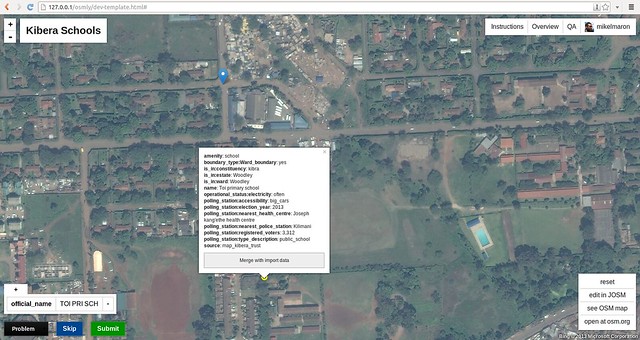
And I have had a lot of questions about it. One of the key parts of our project is to make authoritative data and community data inter-operable. In the process of matching OpenStreetMap schools to Kenya Open Data (KOD) schools, I found something puzzling. The locations in KOD of schools in the Kibera slum were off by hundreds of meters from the OSM data, and not in a consistent way that would suggest a projection issue or such. We have reason to trust the OSM data, as it was collected directly by GPS and confirmed with the community (and, it’s one of the powers of OpenStreetMap that our data story is completely out in the open). Other studies of the KOD data set had also found issues; like research from the World Bank (Points of Knowledge – Crowdsourcing Solutions to Improve Data Accuracy and Re-use in Kenya), which found a majority of primary schools were mis-located. Yet, this was a stupendous data set to put together, a real challenge, over 70,000 schools, back in 2007. How did they do it, and what can we learn?
Last month, I found myself sitting across from Teddy Ochieng at the Gigiri Java House. Through colleagues at USAID Geocenter, I connected with Teddy, currently a GIS officer at USAID. Teddy was generous with his insights on the state of school GIS data. And he just happened to have been a part of the team that collected the 2007 schools data. A man behind the curtain moment!
The Ministry of Education provided a list of over 70000 schools. They started with 15 teams, ending with 10. Each team had 3 people: a lead data collector, an assistant, and a driver. Most all of the data was collected in 2007, but some areas affected by the 2007-8 post-election were hard to reach, and waited until into 2008. They used ArcGIS and Excel to manage data. GPS used were professional end models from Trimble and Magellan, with our old friends the with Garmin eTrex for backup, and manually read and re-digitized the collected latitude / longitude into the database. Data analysis was undertaken in 2010.
Nairobi and other urban areas were particularly challenging. Especially slums — slums are dense, and its sometimes hard to get a signal. The teams had a lot of data to collect, and were in a hurry. To reach many slum schools, you must walk. It’s hard to access by vehicle, often impossible, and it can be uncomfortable and difficult (or even dangerous) for outsiders to roam. This is just conjecture by me, but in searching for a reason, perhaps sometimes the team did not get out of the vehicles. Manual re-entry can also introduce errors. In any case, it seems some factor conspired to introduce some inaccuracies into the schools, especially within informal settlements.
The objective of the project was to go further, and essentially, to set up the Ministry of Education to manage this data better in the future. There are numerous departments like the Information Management Office, and Planning & Quality Assurance, and systems even within the Ministry of Education which don’t keep consistent and linked databases. One key thing they did was assign every primary and secondary school a unique identifier to help with this. Curiously, only the secondary school identifiers made it into OpenDataKE. Ultimately, the hope was to merge all education databases, including the Teachers Service Commission (TSC) which keeps information on teachers, and Kenya National Examinations Council (KNEC). There is even apparently a photo database of each school within the MoE.
I was left with the impression that the challenges in the work Map Kibera has taken on — to link and update school databases in one place — are real ones the Ministry of Education has itself grappled with at a much larger scale. And, I  appreciate much more the impressive challenge of collecting such data for an entire country. This data story reveals an opportunity … if we can find a way for our Open approach to grow, perhaps to county level, then there’s a real repeatable method for keeping school data linked, accurate and up to date. We can take advantage of new networked data collection methods, distributing the cost of data collection to manageable places and to schools themselves.
by: mikel July 16th, 2014 comments:
The two weeks I spent in Kenya in June were probably the most productive and open to possibility since the often referenced 3 weeks of mapping in Kibera back in 2009.
My goal was to lend my weight to the push off of the education mapping project in Kibera. In short, we got our act together to a tight, professional level, and drew into the process people and organizations from all levels. In four parts, the mappers and the media team developed the work plan and logistics for data collection. We organized two groups of community advisors to help guide the project and the website. We informed and gathered support from local government. And I connected with government, NGOs, the tech community, and international development organizations looking at the topics of education & data. And I helped deal with the inevitable daily minor crises that are part of the territory of working in the slums.
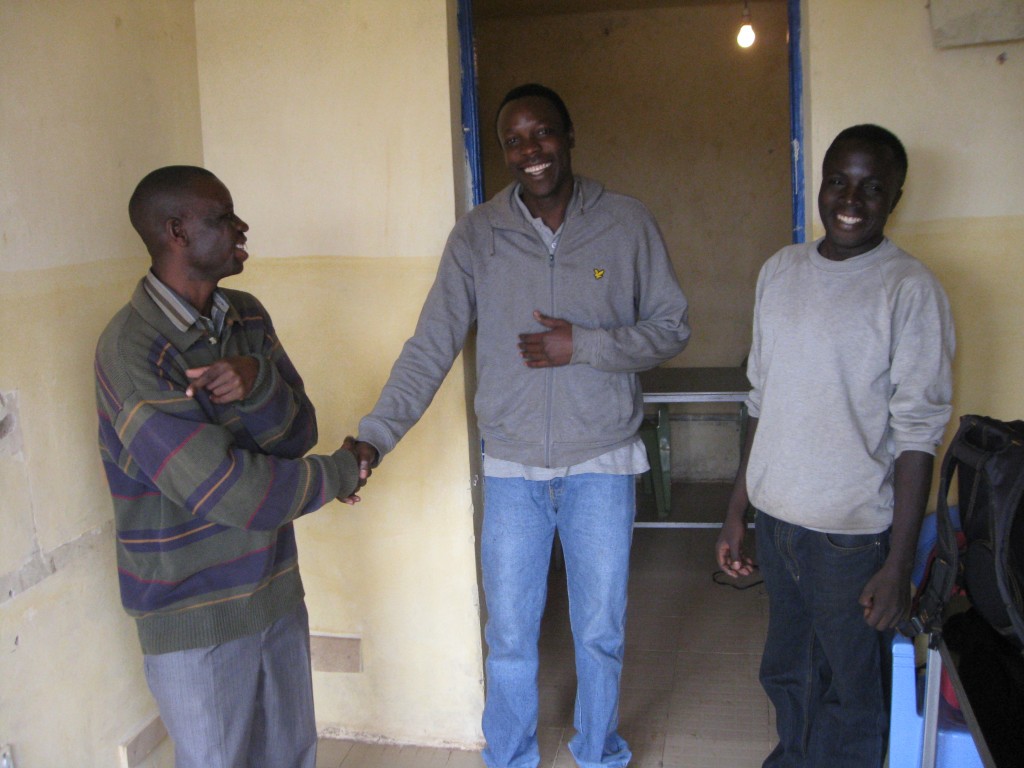
The Kibera team for this project is a focused group of 3 mappers, Zack Wambua, Douglas Namale, and Lucy Fondo; and 3 media guys, Joshua Ogure, Steve Banner, and Jacob Ouma; as well as Yvonne Tiany scoping feasibility in Mathare. We examined the landscape, estimated the work involved in recollecting approximately 250 schools, and geographically divided up the work into three teams. We hashed out the specifics of two dozen data fields for collection, got feedback from our advisory group, settled on the collection form, and preset labels in the map editor for those data fields. There were timelines, contracts to sign, facilities to arrange (Kibera office and iHub), and we started a weekly coordination call on Fridays. The was all easy with our experienced crew.
We were eager to check that we were on track with parents and school heads. We held two focus groups, one with school leaders (at our frequent host Mchanganyiko)Â and one with parents. Most of these folks had already been introduced to, and interviewed for, the project by Joshua, so we could quickly get into details with the presentation and hands on demo of the Open Schools website that we are building. GroundTruth and Development Gateway have been working hard on the basic beta website structure, but had lots of questions on real usage. The energy levels cranked up when they got to use the website itself, real excitement. I hovered and wrote pages of user observations. This led into a very productive dialogue about the project as a whole.
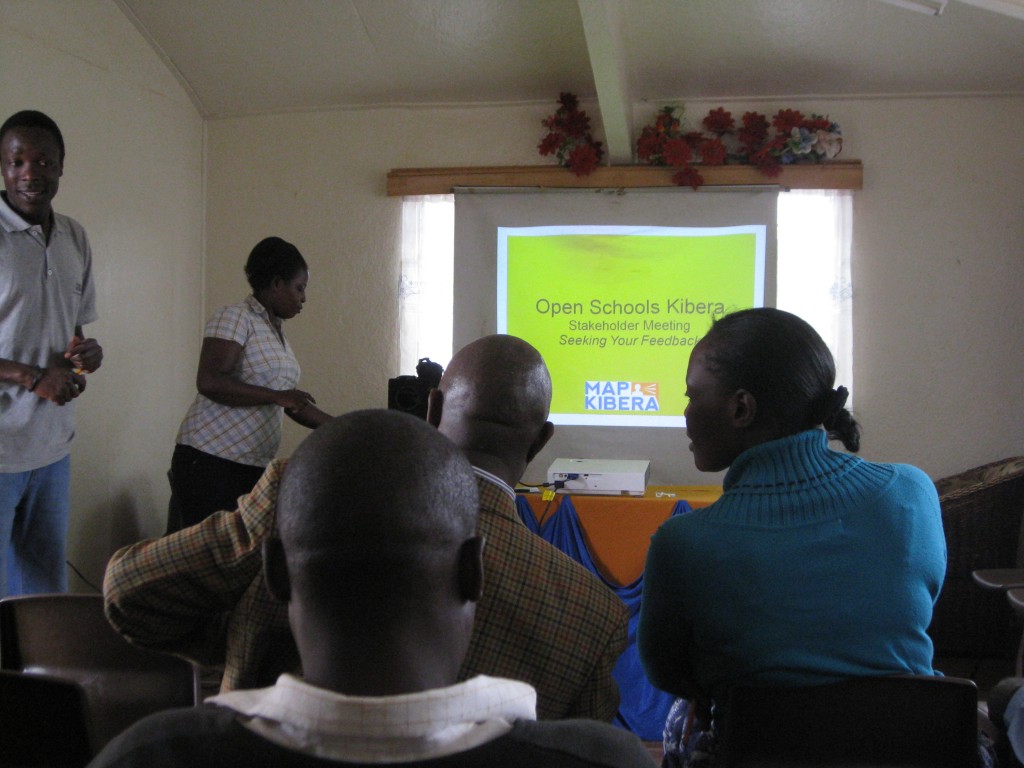
For local government officials, we drafted a formal letter informing on the crucial details of the project, and requesting their support. Happily, the reputation of Map Kibera helped us to secure meetings with these busy individuals, they all gave us signed & stamped support, and expressed genuine interest in the outcomes of the work. It’s important that the administrators and representatives are informed and consulted early in the project. Their support helps assure schools that we are managing the information collected responsibly. We sincerely hope the data will be of use to the Honourable Member of Parliament for Kibra, the Assistant County Commissioner, the County Education Director, the District Education Officer, and the Chief of Saran’gombe.
In my “spare” time, I managed to meet with representatives from various NGOs and international organizations. Fascinating chat with USAID about previous schools mapping. Sharad Sapra from Unicef set some lofty goals for our work (think continent sized). It was great to connect with Concern Worldwid, who are already using our data, and have data on informal schools we can use. Had a whirlwind discussion with Innovations for Poverty Action about half a dozen points of connection. Interesting to check out the operation and insights of Bridge Schools. Promising discussion of mapping with Peace Corps Kenya. Open Institute was generous as ever with their efforts, especially looking at the role of devolution. Had a last minute dinner with Ashoka education innovators. And on top of these, great catching up with friends and exploring everything with Erik Hersman, Matt Berg, Sasha Kinney, and Mark de Blois.
We have lots more to expand on with all these threads. Thanks to everyone for a fulfilling and promising trip. I came away convinced that our approach is needed and our focus on education is timely, and that this project will be of service to improve understanding of education in Kenya.
by: Erica July 3rd, 2014 comments:
How can all the information about Kenyan schools, including data released by the Kenyan government, and citizen mapping, have a greater impact on education? We’ve been working for the past few months on a project to make information about schools much more available and useful in Kenya. It’s a joint operation between GroundTruth Initiative, Map Kibera, Development Gateway, Feedback Labs, and the Gates Foundation among others.
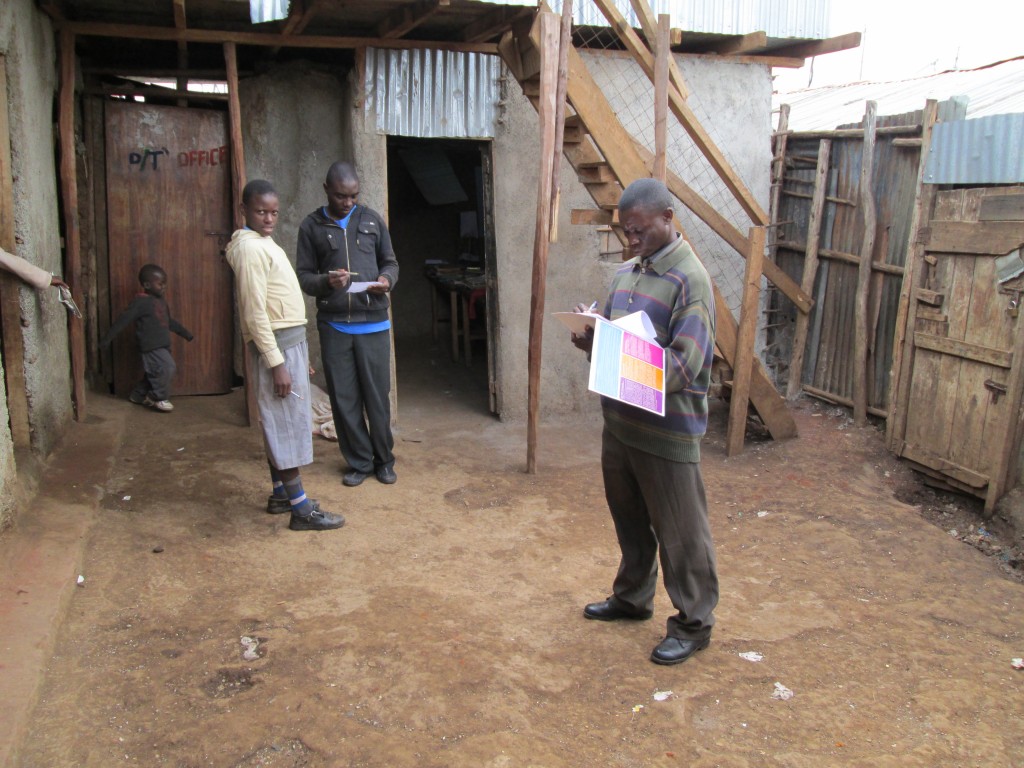
Douglas Namale collects information at Emuhaya Rescue Center school
Many people collect information about education – and they sometimes make it open and free to use. So, why isn’t it easy to find information about a particular school – for a parent, or for an education researcher? Much of the information that’s out there isn’t connected to the other data – and especially when it comes to informal schools, which provide a great deal of the education services in places like informal settlements.
Citizen data – like mapping schools using OpenStreetMap – should also be easy to combine and compare with official education data. And finally, all this info could be accessible and useful to everyone from parents to policymakers.
So, we’ve started with Kibera as a test location for the Open Schools Kenya project (tentative name – what do you think?).
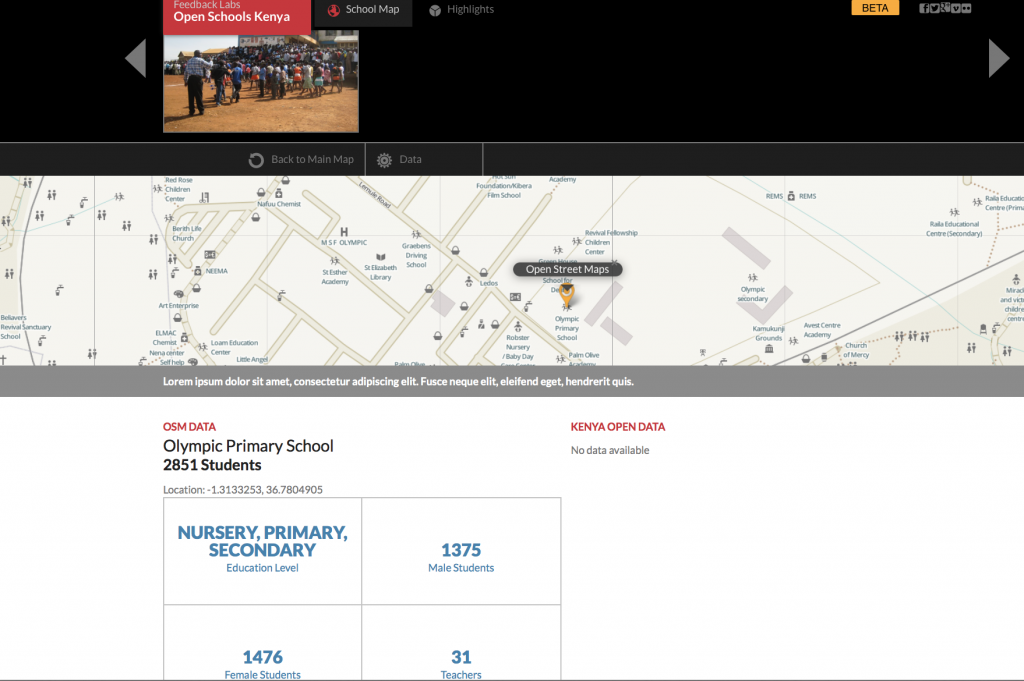
Early Beta Version of Schools Site
Over the past few months, the Map Kibera team has engaged parents, school leaders, and education officials in Kibera to find out how the informal school sector can be more visible, and to assess the demand for information on education. Now, a widespread effort is underway by Map Kibera to make sure that the schools data that the team collected a few years ago is still accurate, and to add new info as well. We’re also collecting photos of each school, no matter how small. Every one will have a page on the website, really bringing the informal school sector to light. Formal schools in Kibera will be there too.
Much of the work so far has been around engaging important leaders in the community, who care about local kids getting the best education. Mikel Maron of GroundTruth was recently in Nairobi working on the project and will be updating in a separate post about this busy trip. Ultimately, the community wants to know more about its schools, and to improve them. So do education supporters throughout Kenya.
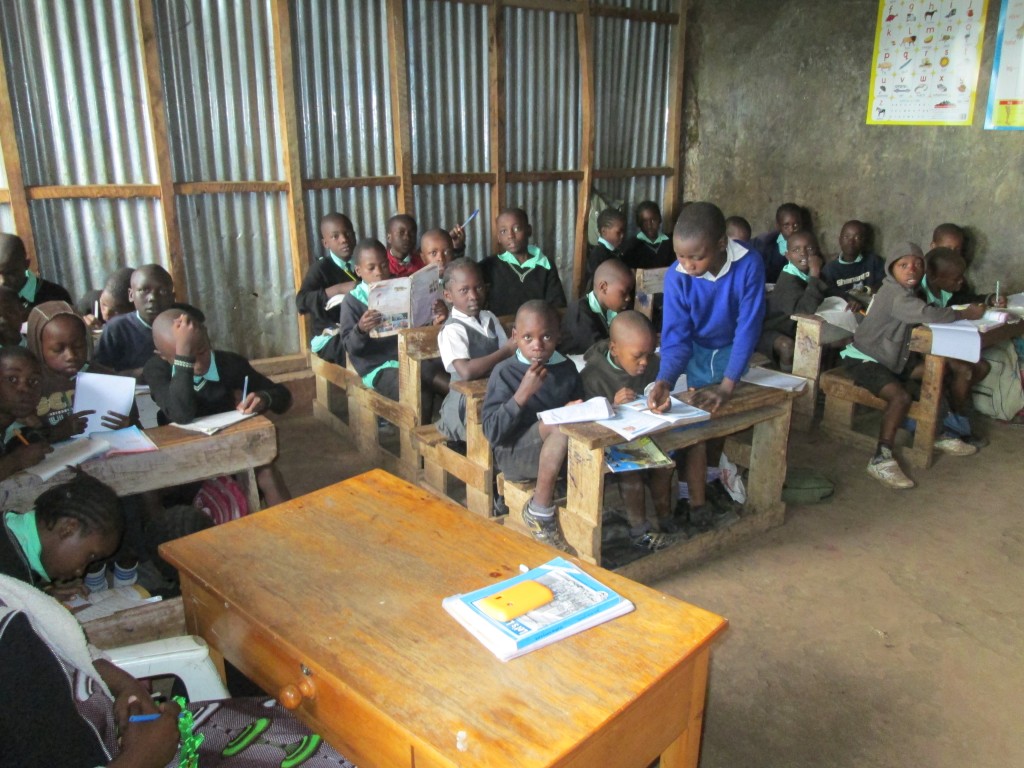
Saviour King School in Kibera
But beyond this important mission of organizing and making interoperable many data sets across the vast education sector in Kenya, we’re also working on an ambitious hypothesis: that parents and community leaders in education will want to provide feedback on schools, which in turn will inform policy and improve individual schools. Ultimately, our platform will be a place where people can not only be consumers of information, but will provide their own opinions and suggestions on schools, and, importantly, submit corrections and updates to the data on the site. Given the early positive response to these ideas, we’re optimistic that this will be possible in Kibera and also Kenya-wide.
The project is not just about education, either. It has far-reaching potential in other sectors as well. We hope to demonstrate that citizen data, official data, academic research and more can come together and be part of a conversation with those on the ground who feel the impact most of government policy in every sector – ordinary citizens. And, that this kind of conversation means that people “own†their own information, and we can see the beginnings of a true “feedback loop†or dialogue between citizens and government, through the medium of shared data.





